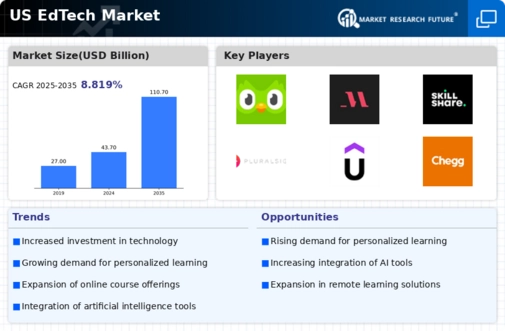The US EdTech market has experienced significant growth and innovation in recent years, driven by technological advancements, changing educational needs, and an increasing demand for flexible learning solutions. This competitive landscape is characterized by a diverse array of players, ranging from startups to established firms, all vying for market share by offering unique platforms and services aimed at enhancing educational experiences for both traditional and non-traditional learners.
Key trends influencing this market include the increasing integration of artificial intelligence and data analytics in educational tools, the rising popularity of online and hybrid learning models, and an overall shift towards personalized learning pathways that cater to individual student needs.
As these factors shape the dynamics of the market, companies must stay agile and responsive to both technological advancements and evolving consumer preferences to maintain their competitive edge. Duolingo has established itself as a leader within the US EdTech landscape, primarily known for its language learning app, which combines gamification with an intuitive user interface. The company’s strengths lie in its ability to offer a free, user-friendly platform that actively engages learners through interactive exercises and a reward system that encourages regular practice.
By utilizing cutting-edge algorithms to adapt lessons according to individual progress and learning styles, Duolingo has positioned itself as a go-to resource for anyone looking to learn a new language.
Its market presence is marked by a strong brand loyalty and a vast user base, allowing the company to flourish in a crowded marketplace. Focused on accessibility and inclusivity, Duolingo also provides a free version of its platform alongside a premium subscription plan, broadening its appeal to various user demographics across the US.MasterClass has carved out a unique niche within the US EdTech sector by offering high-quality online courses delivered by renowned experts in various fields, ranging from arts to business.
Its primary strength lies in the premium content that emphasizes expert-led learning experiences, enabling users to gain insights from industry leaders. The company's market presence is bolstered by a strong branding strategy and partnerships that help elevate its credibility as a serious educational platform. MasterClass's subscription model allows users unlimited access to its library of classes, thereby making it feasible for learners to explore multiple subjects at their own pace.
Additionally, the company has enhanced its growth through strategic mergers and acquisitions, which have not only expanded its content offerings but also integrated new technologies that enrich user engagement. With a focus on delivering quality and engaging lessons, MasterClass stands out as a premium choice in the EdTech market that caters to both aspiring professionals and curious learners looking for an enriching educational experience.
























